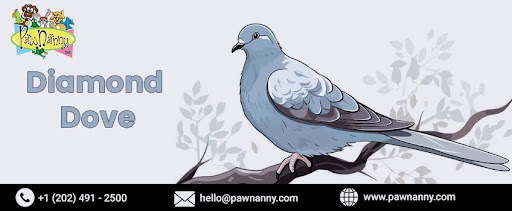
Diamond Dove
Scientific Name: Geopelia Cuneata
Flock Members: 2-10 members
Size: 7.5-8.3 inches
Weight: 0.8-1.1 ounces
Lifespan: 5-15 years
A.K.A.: Little Doves
Behavior
Diamond doves are small, beautiful birds known for their gentle and peaceful nature. They exhibit fascinating behaviors that make them a delight to observe and keep as pets. These doves are typically found in pairs or small flocks, and they display strong social bonds within their groups. They engage in various social behaviors such as preening each other's feathers, huddling together for warmth, and vocalizing to communicate with one another, also seen during pet overnight stays.
One remarkable behavior of diamond doves is their courtship display. During courtship, the male will bob its head, puff up its chest, and coo softly to attract the female's attention. They may also engage in aerial displays, flying in circles while vocalizing. Once a pair bond is formed, they become devoted partners, often staying together for life. Diamond doves are ground-dwelling birds and spend much of their time foraging on the ground for seeds and grains. They are known to be excellent climbers and can navigate trees and shrubs with ease. They have a gentle and calm demeanor, rarely engaging in aggressive behaviors towards other birds or humans, and stay calm even during pet overnight services.
In terms of vocalization, diamond doves have a soft and melodious cooing sound. They use their vocalizations to communicate with their flock members and establish territory boundaries. These calls are soothing and pleasant to the human ears. Their social behaviors, courtship displays, ground foraging, melodious cooing, and skilled nest building make them a captivating species to observe and appreciate.
History
Diamond doves are native to Australia, where they inhabit a range of habitats, including grasslands, savannahs, and scrublands. The history of diamond doves traces back to their discovery and subsequent popularity as aviary birds. The species was first scientifically described by John Gould, an English ornithologist, in 1844. Their name "diamond dove" refers to the distinct white spots on their wings that resemble diamonds. Initially, diamond doves were primarily found in the northern regions of Australia, but due to their captivating appearance and gentle nature, they quickly gained popularity among aviculturists. Their popularity led to the exportation of diamond doves to other countries, where they became sought-after as aviary birds. Their small size, peaceful demeanor, and attractive plumage made them a favorite choice for bird enthusiasts around the world.
Over time, successful breeding programs in captivity further increased their availability, making them more accessible to birdkeepers. Today, diamond doves are commonly found in aviculture globally and are popular pets due to their beauty and ease of care. In addition to their presence in aviaries and households, diamond doves continue to thrive in the wild across their native range in Australia. They are adaptable birds that have successfully adapted to various habitats, including urban environments. The history of diamond doves showcases their journey from being native Australian birds to becoming cherished aviary birds worldwide. Their striking appearance, gentle temperament, and ability to adapt have ensured their continued popularity and presence in both captive and wild settings.
Breeding
The breeding season for diamond doves typically occurs during the warmer months, although they can breed throughout the year in suitable conditions. During courtship, the male initiates a series of displays to attract the female. This includes bobbing its head, puffing up its chest, and cooing softly. The male may also perform aerial displays, flying in circles while vocalizing to impress the female. Once a pair bond is formed, the male and female work together to construct a nest. The nest is usually a small, well-hidden structure made of twigs, grass, and feathers. Both partners contribute to nest building, with the male bringing the materials and the female arranging them.
After the nest is completed, the female lays one or two eggs, which she incubates along with the male. The incubation period lasts for about 13 to 14 days. Both parents take turns sitting on the eggs, ensuring their warmth and protection. Once the eggs hatch, the parents feed the chicks a special secretion known as "crop milk" produced in their crop. This highly nutritious substance provides essential nutrients for the growing chicks. Both parents participate in feeding and caring for the young, taking turns to ensure their well-being. The chicks grow rapidly and fledge from the nest after approximately two weeks. The parents continue to care for and feed the fledglings for several more weeks until they become independent.
Food & Nutrition
These small birds have specific dietary requirements that should be met to ensure their optimal growth and vitality. In the wild, diamond doves primarily feed on a variety of seeds, including grass seeds, millets, and small grains. In captivity, a high-quality commercial dove or finch seed mix serves as a suitable base diet. This mix should contain a variety of seeds, such as millet, canary grass seed, and small sunflower seeds. It is essential to provide fresh, clean water at all times for hydration.
Supplementing their diet with fresh fruits and vegetables is beneficial for diamond doves. Offer small amounts of chopped fruits like apples, pears, and berries, as well as leafy greens like lettuce, spinach, and dandelion leaves. These provide essential vitamins, minerals, and fiber. Additionally, calcium supplementation is important for maintaining strong bones and eggshell formation, especially for breeding pairs. Crushed eggshells or commercially available calcium supplements can be provided.
Diamond doves may also benefit from occasional protein sources such as mealworms or small insects. These can be offered as a treat or during the breeding season to support optimal growth and reproduction.
Conclusion
Diamond doves are captivating birds that can be enjoyed both as pets and in their natural habitat in the wild. Their gentle nature, beautiful plumage, and low maintenance requirements make them popular choices for bird enthusiasts and pets overnight stay services.
As pets, diamond doves are cherished for their peaceful demeanor and relatively easy care. They are small in size, making them suitable for keeping in aviaries or spacious cages. These birds require a well-balanced diet consisting of a high-quality seed mix, fresh fruits, and vegetables. Providing ample space for flying and perching, along with regular social interaction, helps keep them mentally stimulated and happy. With proper care and a suitable environment, diamond doves can thrive as pets, captivating their owners with their beauty and melodious cooing. In the wild, diamond doves inhabit a range of habitats across Australia. They are adaptable birds, found in grasslands, savannahs, scrublands, and even urban environments. In their natural habitat, they forage on the ground for seeds, grains, and insects. They form small flocks or pairs, engaging in social behaviors such as preening, huddling for warmth, and vocalizing to communicate. In the breeding season, they construct nests and engage in courtship displays to attract mates.
Observing diamond doves in the wild offers a glimpse into their natural behaviors and interactions with their environment. Their presence adds beauty and charm to the ecosystems they inhabit, contributing to the overall biodiversity and ecological balance. Whether as pets or in the wild, diamond doves bring joy and fascination to those who appreciate their elegance, gentle nature, and unique characteristics. For more information, or avail our pets overnight stays services Fairfax VA, visit our website - Pawnanny.com .










